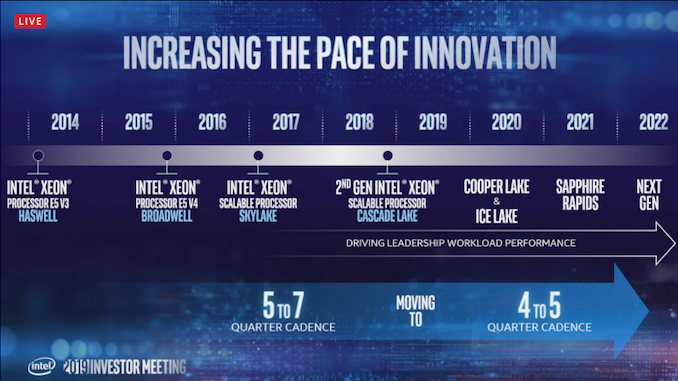Intel Confirms 10nm Ice Lake Xeon Production Has Started
by Dr. Ian Cutress on January 11, 2021 4:30 PM EST- Posted in
- CPUs
- Intel
- Trade Shows
- 10nm
- Ice Lake
- CES 2021
- Ice Lake-SP

As part of this week’s announcements, Intel has confirmed to AnandTech that it has started production its next generation server processors, known as Ice Lake 3rd Generation Xeon Scalable. This news is somewhat at odds with remarks made by the CEO Bob Swan – it doesn’t fit into the timeline of how Intel’s processor production usually works, and the discrepency appears to go beyond simple terminology.
When a company like Intel creates a new generation of server processor, either using a new microarchitecture or process node (or both), iterations and revisions of that server processor are made as the design is tweaked and optimized. Throughout the process, Intel’s largest customers, notably the hyperscalers in today’s environment, get early access to this beta hardware. Part of the agreement to access is helping Intel debug and tune the design, as well as placing a big, hefty order. Throughout this process, the customer will use the beta hardware to tune their own software platforms, and in some instances, move the product into deployment-level infrastructure. Note that as the product gets nearer launch, these key customers will have thousands upon thousands of ‘engineering samples’ in various states of performance and usability. The line at which the customer gets shipped ‘full retail’ units rather that beta hardware is blurred, especially as these customers will often keep hold of the engineering samples that work as expected.
So not only is there this overlap, but also the key customers that help Intel in this regard get the first production-ready units. More often than not, Intel will hold back any formal public announcement of the product until the quota from the key customers is met, after which Intel can finally sell it to the wider masses, known as 'general availability'. This lead time can vary to as much as six months, during which time those big customers are getting the latest and greatest chips from Intel while the rest of the world doesn’t know the new hardware is ready.
Because of this staggared rollout, there's a fine line (if not a fine mess) in the exact wording that is used for saying that Intel's server chips have been released, especially when comparing ‘announcements’ to ‘launches’ to ‘shipping for revenue’ to ‘general availability’ or ‘ramping production’ (scaling up manufacturing to build more).
In our interview with CEO Bob Swan, also posted today, he stated that the Ice Lake Xeon Scalable product has been launched in 2020. This is news to us, as there was no formal announcement. However what he might be talking about is that it ‘launched’ to those key customers. In that sense, the product is shipping for revenue. However, in the same instance, he also said that Ice Lake Xeon Scalable was ramping up production in Intel’s 10nm facilities. This would suggest that while Intel has been producing the hardware for a while, it is only now at a point where it feels comfortable adding more volume to meet expected demand.
However, in the official press release from Intel today, the company says that it is ‘starting production’ of Ice Lake Xeon Scalable, with ‘volume ramp taking place during Q1 2021’. This would seem to suggest that Intel is only just starting production of a finished version of the hardware, and that the product ramp is still to come later in the quarter.
So either Ice Lake Xeon is launched, or it isn’t. It’s either in production, or it’s starting to ramp, or it is ramping, or production will be ramped as we move through Q1. Whatever Intel is trying to say here, your guess is as good as mine. I know some of my critics might call me out for not accepting what is being said at face value, or claim that what Intel is saying is clear. It’s a bit wishy-washy, and some of it is contradictory. I think we would all hope that Intel would be precise in describing its next generation of revenue generating data-center product.
With Intel’s end-of-year financial disclosures in a couple of weeks, we might get more insight into Intel’s Ice Lake Xeon Scalable status, along with a more public launch somewhere along the line, and discussions about Intel’s plans for its manufacturing beyond 10nm. If Ice Lake is indeed 'launched' in FY2020, that would mean Intel met a FY2020 target, which is likely to be important to investors.
Related Reading
- Interview with Intel CEO Bob Swan
- Intel at CES 2021: Overview
- Intel at CES 2021: Press Event Live Blog
- Intel Ice Lake Xeon in Production
- Intel 11th Gen Desktop Rocket Lake Core i9-11900K ‘Preview’
- Intel 11th Gen Tiger Lake-U Boosted to 35W
- Intel 11th Gen Tiger Lake-H with 8 cores
- Intel 11th Gen Tiger Lake Goes vPro
- Intel’s Next Gen Tremont Atom in Jasper Lake for Q1











9 Comments
View All Comments
supdawgwtfd - Monday, January 11, 2021 - link
"So this is where we get into a mix about exact working on when a product, "This isn't proper English.
Not sure what word is missing or wrong but something isn't right.
Reading out loud is a nice basic way to check your work.
supdawgwtfd - Monday, January 11, 2021 - link
"This would seem to suggest that Intel only just starting production of a finished version of the hardware"Also broken.
Missing an "is" there perhaps?
Assimilator87 - Monday, January 11, 2021 - link
Perhaps the confusing writing is an analogy to Intel's perplexing roadmap ;-)mode_13h - Tuesday, January 12, 2021 - link
Exactly how many years late is it, relative to their first roadmap featuring Ice Lake Xeon? I'm pretty sure it was originally supposed to launch in 2018, if not before.And we have yet to see what availability is like. Are they even saying how many cores it has or what pricing is like?
Spunjji - Tuesday, January 12, 2021 - link
It should have been where Cascade Lake is. 😬nitram_tpr - Tuesday, January 12, 2021 - link
Seriously guys, you really need to spell check or at least read through your articles before you post them" Intel has confirmed to AnandTech that it has started production its next generation server processors"
Missing an *on* there? Very sloppy and it is happening more and more.
Gondalf - Tuesday, January 12, 2021 - link
In my knowledge are years that Intel ship their best silicon to very large customers first. No surprised here if Intel is a little stealth to not bash too much small customers, they want the new SKU too, but Intel is busy supplying large datacenters, first.So they say it is in production....small fishes have to wait the big stockpile.
Amd have the same behavior with Epyc
Spunjji - Tuesday, January 12, 2021 - link
Ouch! I'd assume the latest dates given are the true ones - why would they give worse dates than are true? Looks like they're still having trouble getting their "alternative facts" lined up.mode_13h - Tuesday, January 12, 2021 - link
Yes, sounds like there's a phase-error in the reality-distortion field.